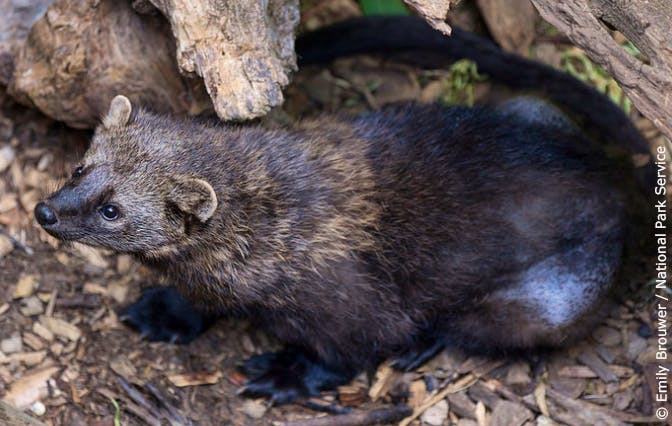As observations of Montana fishers grow scarce, we need to take new steps to help protect the elusive forest creatures.
I want to see a fisher in Montana.
I work on hopeful steps towards this species’ conservation almost every day. But darn it, not only are they fairly shy and elusive, they are rare out here. Evidence suggests their numbers are extremely low in the state.
There is no simple solution for conservation of these and other rare, elusive animals. You have to play the long game, with multiple approaches to multiple threats. It always involves developing relationships and interactions with a variety of partners and agencies. It’s rarely simple, often nuanced, and a constant challenge to get enough information on the species’ population, distribution, habitat needs, and how it responds to threats. And yet, to help these species, we and land and wildlife managers have to make decisions based on whatever information is available. Fisher conservation in the northern Rockies is no different.
Where’s Waldo? Fishers in Montana are hard to find
A relative of mink, otter and wolverine, fishers (Pekania pennanti) sport the thick soft fur, narrow bodies, sharp noses, and long bushy tails of the weasel family. These rare and agile forest carnivores are found only in North America. They rely heavily on hollow trees and logs, and large, connected expanses of mature trees to make their living.
In the Northern Rockies, the fisher has been so reduced in its range and numbers that it is one of the rarest carnivores in the region. Trapping of fishers, logging of old-growth forests, and enormous forest fires nearly drove them extinct in the early 20th century. Today, logging and human development continue to eat away at the forests that fishers rely on. Driven by climate change, more frequent and severe fires are also claiming fisher habitat.
Within Montana, there is major concern for the fisher population. Fisher habitat in the state is already naturally somewhat limited, occurring only in Western Montana. Many wildlife researchers are seeking fishers in our forests, but coming up empty – including our own citizen science efforts. Of course, this doesn’t mean that there are absolutely no fishers anywhere in all those monitored areas — but it’s certainly cause for concern. It most likely means that there are very few fishers left in the state of Montana. It’s tough to prove the absence of something, but all the evidence points to a very small population indeed.

A fisher in a trap is not worth two in the bush
Despite their very low numbers, it is still legal in Montana to trap fishers. And that’s quite a problem because fishers are highly vulnerable to trapping, both purposeful and accidental (in traps set for other species). Being a curious, bold weasel species, they are fairly easily lured into traps. And their slow reproductive rate means that the population can take a long time to recover if too many fishers are killed too quickly, so trapping can be a significant cause of severe fisher population decline.
We are working hard to address the array of threats to fishers and their forested habitat. But given the latest research and what it has – or rather, hasn’t – found, we have recently been focusing even more on the issue of fisher trapping in Montana, and pushing for an end to this practice when populations appear to be so low. The number of fishers allowed to legally be trapped is fairly low, with just seven allowed across the state each year. It may not sound like much, but, even this small number can negatively impact small, low-density populations like Northern Rockies fisher.
Right now, Montana Fish Wildlife and Parks (FWP) does not know how big or small the state’s fisher population is, or how well it is doing. Based on that alone, it just isn’t responsible to allow a trapping season. The other threats to fishers can be tricky and may take some time to address. But trapping is clearly and directly killing fishers, and we and wildlife managers can do something about this impact right now.
No giant leap, but some small steps forward for fishers
In May, the FWP commission (a governing body that helps guide the agency) tentatively decided to reduce the fisher trapping quota from seven to zero; a major step in the right direction. A public comment period ensued, the FWP agency made a different proposal, and two months later, the FWP commission accepted it and the final decision was made.
It wasn’t quite what we had hoped for. The final decision continued to allow fisher trapping, reducing the quota by just one, to six total. We were obviously disappointed that fisher trapping will continue in Montana for now and this is something we’ll continue to oppose.
However, the agency also took some positive steps. They created four fisher management units based on the unique history, status, and conservation approaches needed in each area, and closed one of those units to fisher trapping completely. They also committed to drawing up a fisher management plan, which is an important piece of the conservation puzzle that the state has never had.
We’re hoping that the next steps will be more stakeholders including Idaho Fish and Game, the Forest Service, and others working together on a multi-agency, multi-pronged long-term fisher conservation strategy. We also need to know more about how fishers are doing – how many there are in the state, and where. That means a state monitoring program. All things we’ll continue to push for as we work with state and local officials to help these and other native forest carnivores.
Fishers are rare in the Rockies. With their small and isolated population, fishers need a long-term, science-based conservation strategy that protects the existing population and encourages it to grow and expand. With a lot of work and a little luck, maybe one day I’ll see a wild fisher in my home state.




